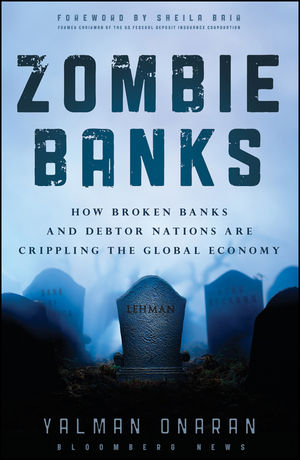REVIEW:  Zombie Banks: How Broken Banks and Debtor Nations Are Crippling the Global Economy by Yalman Onaran.
Zombie Banks: How Broken Banks and Debtor Nations Are Crippling the Global Economy by Yalman Onaran.
~~~
Do We Love Zombie Banks?
The new book by Yalman Onaran of Bloomberg News, Zombie Banks: How Broken Banks and Debtor Nations Are Crippling the Global Economy, is a well-organized and clearly written discussion of the use of leverage to provide growth in many different economies. The vehicle for funding this ersatz growth is the “zombie bank,” a metaphor which, the author notes, Boston University’s Ed Kame helped to popularize with respect to money center banks.
Onaran has carefully researched the zombie phenomenon and makes some important points in this concise volume about both public policy and the concerns of investors. One of the more interesting early threads in the book is the juxtaposition of the experience of the US in the S&L crisis and Japan in the 1980s and 1990s with the US today. Onaran notes that when the Japanese finally did get around to cleaning up their real estate mess, banks were closed and portfolios restructured at deep discounts, but the world did not end.
“Even though the [Japanese] government spent about $495 billion for these efforts initially,” he writes, “it managed to recoup about half of its investment when selling the bad assets in the next three years.” Similar could be said about the US cleanup of the S&L crisis, but that may have only been the case because real estate prices continued to rise from the 1980s through the mid-2000s.
But the more important point made by the author in his skillful reflection of the work of my friend Ed Kane and other scholars with respect to the S&L mess is that is takes a long time for political systems to address the asset quality and solvency problems that qualify banks for zombie status. Onaran notes that Kane believes that it may take another “four or five years for the full resolution. As we’ve seen from the thrift and Japanese crises, that delay will only increase the costs to society and hold back economic recovery.”
This book is not Shakespeare, but instead a series of bite-sized observations on the zombie in the global economy phenomenon written in that tight style familiar to readers of Bloomberg News. Both politically and in terms of the actual financial cost, Onaran documents some of the more interesting aspects of why governments seem to tolerate the too-big-to-fail banks, but like another friend and author Mike Mayo, he never quite comes to the obvious conclusion, namely that we really love zombies.
The author kindly quotes this reviewer as saying that zombies eat money rather than people, a statement which is obviously true but misses the real point — namely that zombies also spend money and are the drivers of employment, financial booms and busts. Banks such as Citigroup, Countrywide and Lehman Brothers failed because they took too much risk, but in doing so created a lot of nominal growth which is mother’s milk for politicians. No member of Congress really wants to kill zombies.
Onaran notes that along with the problem of zombie banks the issue of cleaning up the real estate market remains unaddressed, a situation which stems from the same political reality that makes us love zombies. After WWII, it was considered scandalous and shocking when politicians suggested that national banks be permitted to make 70 LTV mortgage loans. Today the reform proposals to liquidate zombies like Fannie Mae and Freddie Mac put forward by Republicans suggest 95 LTV loans as the standard template for “qualified” residential mortgage loans.
Zombies are vehicles for an economic cycle built upon debt and bad money, and driven by the post WWII demographic reality known as the baby boom. During the peak of the housing boom in 2005, when zombie moneycenter banks and GSEs were competing with one another to buy residential mortgages from smaller banks and non-bank originators, the fact of the zombies made credit far more available for consumers.
The “democratization of credit” described by authors like Jim Grant and now further detailed by Onaran in Zombie Banks inevitably involves losses as credit expands. The losses on these giant creators and aggregators of leverage are then socialized despite the best efforts to prevent this despicable but very popular evil. But the inefficiency of the zombies makes that growth very expensive, a fact that Fed officials ignore even as they use the large banks as convenient conduits for monetary policy.
“Ironically, the political debate over how to restart the global economy is devoid of any acknowledgement of the role a bloated financial services industry plays in impeding growth,” writes former FDIC Chairman Sheila Bair in the introduction to Zombie Banks. “Until government policymakers come to grips with the basic economic truths reflected in this book, our road to recovery will be a very slow and costly one.”
Zombie Banks is a good review of the latest thinking about the ebb and flow of the political economy.

